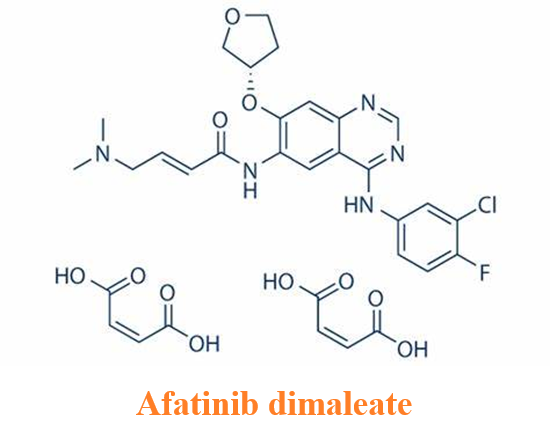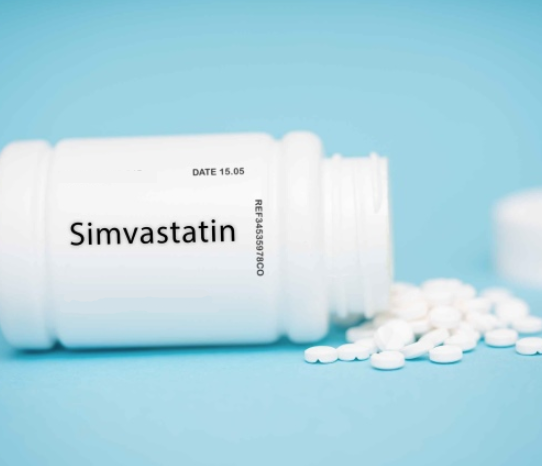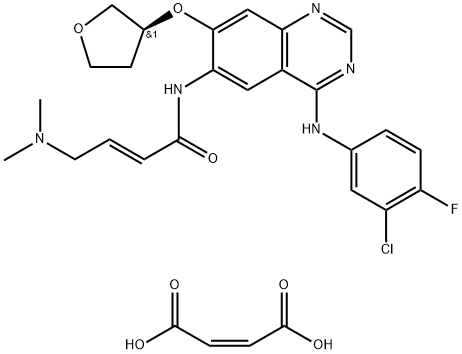Afatinib dimaleate: Chemical properties, Indications, Mechanism of action and Side effects
Sep 2,2024
Chemical properties
Afatinib dimaleate is the salt form of Afatinib, a crystalline compound whose structure is shown in Figure 1 below.Afatinib has two basic groups, dimethylamine (pKa 8.2) and quinazoline (pKa 5.0). Afatinib dimaleate is very soluble in water and aqueous buffers with a pH of 1 to 6 (> 50 mg/ mL). The free base is strongly lipophilic (log P = 4.7) but is strongly pH dependent. Afatinib covalently binds to the epidermal growth factor receptor. The molecule is sensitive to the humidity of the drug and the tablet.

Indications
The branded drug ‘Gilotrif’ tablets, developed by Boehringer Ingelheim, are formulated with Afatinib dimaleate as the main ingredient. It is approved by the FDA for the treatment of patients with metastatic non-small cell lung cancer (NSCLC). The disease is associated with non-drug resistant epidermal growth factor receptor (EGFR) mutations. It is also used to treat patients with metastatic squamous NSCLC whose disease has progressed after platinum-based chemotherapy.
Mechanism of action
Afatinib is an orally bioavailable anilinoquinazoline derivative, an inhibitor of the receptor tyrosine kinase (RTK) epidermal growth factor receptor (ErbB; epidermal growth factor receptor) family, with antitumour activity. The mechanism of action is that afatinib works by selectively and irreversibly interacting with epidermal growth factor receptors 1 (ErbB1; epidermal growth factor receptor), 2 (ErbB2; epidermal growth factor receptor HER2), and 4 (ErbB4; epidermal growth factor receptor HER4), as well as with certain epidermal growth factor receptor mutants including those consisting of a deletion mutation in exon 19 of the epidermal growth factor receptor or a deletion mutation in mutants caused by mutations in exon 21 (L858R)) bind and inhibit them. This may inhibit tumour growth and angiogenesis in tumour cells overexpressing these RTKs. In addition, afatinib inhibits the epidermal growth factor receptor T790M gatekeeper mutation that is resistant to treatment with first-generation epidermal growth factor receptor inhibitors. Epidermal growth factor receptor (EGFR), HER2 and HER4 are RTKs belonging to the epidermal growth factor receptor superfamily; they play an important role in tumour cell proliferation and tumour angiogenesis and are overexpressed in many cancer cell types.
Side effects
The most common adverse reactions to Afatinib dimaleate include diarrhoea, rash/acne-like dermatitis, stomatitis, paronychia, dry skin, decreased appetite, nausea, vomiting, pruritus, vomiting, and pruritus. Serious adverse reactions may appear to present with dyspnoea, malaise, hypokalaemia, sepsis, pneumonia, hepatotoxicity and keratitis. Other possible side effects include pancreatitis, Toxic epidermal necrolysis/Stevens Johnson syndrome. Seek medical attention if any of these adverse reactions occur.
- Related articles
- Related Qustion
- Side effects of afatinib dimaleate Mar 25, 2025
Afatinib dimaleate, the dimaleate form of afatinib, is an orally bioavailable anilinoquinazoline derivative that is an inhibitor of the epidermal growth factor receptor (ErbB; EGFR) family of receptor tyrosine kinases (RTKs) with antitumor
- BIBW2992 DiMaleate: pharmacokinetic, clinical applications and safety Nov 20, 2023
BIBW2992 DiMaleate is a well-tolerated medication for certain types of lung cancer, showing bioequivalence and efficacy in clinical studies.
- BIBW2992 Dimaleate - Pharmacodynamics Dec 13, 2019
Afatinib dimaleate (Tovok; BIBW2992; Gilotrif) is a salt form of Afatinib. Afatinib is a second-generation, orally administered, irreversible inhibitor of the ErbB family of tyrosine kinases.
Supplementation with pyridoxal 5'-phosphate monohydrate can synthesize neurotransmitters such as dopamine and serotonin, maintaining a healthy nervous system.....
Nov 4,2025Biochemical EngineeringSimvastatin is used to lower blood levels of "bad" cholesterol (low-density lipoprotein, or LDL), to increase levels of "good" cholesterol (high-density lipoprotein, or HDL), and to lower triglycerides (a type of fat in the blood).....
Sep 2,2024DrugsAfatinib dimaleate
850140-73-7You may like
Afatinib dimaleate manufacturers
- Afatinib dimaleate
-

- $0.00 / 1g
- 2025-12-17
- CAS:850140-73-7
- Min. Order: 1g
- Purity: 99%min
- Supply Ability: 1000g
- Afatinib Dimaleate
-

- $33.00 / 5mg
- 2025-12-16
- CAS:850140-73-7
- Min. Order:
- Purity: 99.87%
- Supply Ability: 10g
- Afatinib DIMELATE
-

- $2800.00 / 1kg
- 2025-12-11
- CAS:850140-73-7
- Min. Order: 0.1kg
- Purity: 99
- Supply Ability: 10






